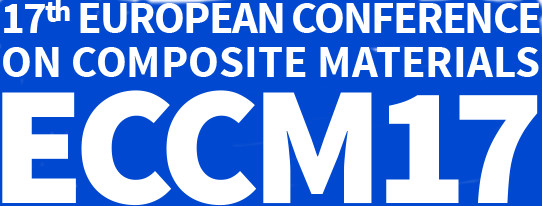

App-Einstellungen:
MULTISCALE MODELING OF A HIGHLY REINFORCED THERMOPLASTIC COMPOSITE : FROM MICROSTRUCTURAL SIMULATIONS OF THE TRANSVERSE DAMAGE KINETICS TOWARDS ENGINEERING STRUCTURE COMPUTATIONS.
Pierre-Alexis Poulet (MINES ParisTech) Sébastien Joannès (MINES ParisTech) Lucien Laiarinandrasana (MINES ParisTech)
Finite Element simulations based on representative periodic cells highlighted the effects of the variability of the microstructure on the stress-strain curve, as well as on the evolution of the porosity in the matrix between fibres.
A FINITE ELEMENT MODEL FOR PLAIN WEAVE FABRIC BASED ON AN INNER BEAM STRUCTURE
Benjamin Kaiser (Technische Hochschule Mittelhessen) Thomas Pyttel (Technische Hochschule Mittelhessen) Eberhard Haug (ESI Group) Fabian Duddeck (Technical University of Munich)
The paper presents a finite shell element for plain weave fabrics. It is designed for draping and forming simulations. Instead of a classical constitutive law, a unit cell is modeled with crossed beams.
COMPACT TENSION AND COMPRESSION TESTING OF BRAIDED COMPOSITES – CHALLENGES AND LIMITATIONS
Sebastian Kilchert (Fraunhofer EMI) Tobias Gerster (Fraunhofer EMI) Matthias Nossek (BMW Group) Jens Fritsch (Fraunhofer EMI) Michael May (Fraunhofer EMI)
The present publication aims to identify challenges and limitations of existing compact tension and compression test procedures applied to braided Composites.
CHARACTERIZATION OF WRINKLING AND DE-WRINKLING BEHAVIOUR OF WOVEN FABRICS USING A MULTI-STEP BIAXIAL BIAS EXTENSION TEST
Armin Rashidi Mehrabadi (University of Bristol) Abbas Milani (University of Bristol)
A multi-step biaxial bias extension (MBBE) test procedure is proposed to characterize forming and flattening of wrinkles of different sizes at shear angles below and above the locking, as both often seen in the composites thermo-forming practice.
EFFECT OF SPECIMEN WIDTH ON STRENGTH IN OFF-AXIS COMPRESSION TESTS
Dennis Wilhelmsson (Chalmers University of Technology) Leif Asp (Chalmers University of Technology) Renaud Gutkin (Swerea SICOMP) Fredrik Edgren (GKN Aerospace)
Compression tests have been performed according to ASTM D6641 to check whether 12 mm is a sufficient width for off-axis tests of a unidirectional Non Crimp Fabric (NCF) reinforced carbon-fibre composite.
NUMERICAL SIMULATION OF TRIAXIAL WOVEN CFRP UNDER TENSILE LOADING
Jun Koyanagi (Tokyo University of Science) Erina Imai (Tokyo University of Science) Ryo Higuchi (Graduate School of Tohoku University) Akinori Yoshimura (Japan Aerospace Exploration Agency) Tomonaga Okabe (Tohoku University) Satoru Yoneyama (Aoyama Gakuin University) Takahira Aoki (University of Tokyo)
Triaxial woven CFRP is numerically modeled by finite element analysis very accuately. Under a tensile loading, strain distribution obtained numerically is compared with that obtained experimentally. They show good agreement.
VIRTUAL MECHANICAL TESTING OF A COMPLEX 3D WOVEN FABRIC: A UNIFIED SIMULATION METHODOLOGY FOR DEFORMATION MECHANICS OF TEXTILE STRUCTURES DURING TENSION, SHEAR AND DRAPING
Lode Daelemans (Ghent University) Jana Faes (Ghent University) Samir Allaoui (Univ Orléans) Gilles Hivet (Univ Orléans) Wim Van Paepegem (Ghent University)
We show a viable simulation methodology which allows for the virtual testing of fibrous materials such as 3D woven fabrics based on the digital element concept.
STRESSES ALONG THE HOLE BOUNDARY OF UNSYMMETRIC COMPOSITE LAMINATES VIA BOUNDARY ELEMENT METHOD
Chyanbin Hwu (National Cheng Kung University) H. W. Chang (National Cheng Kung University)
The unsymmetric composite laminates are analyzed by the coupled stretching-bending boundary element. To avoid the singular problem encountered on the boundary node, a new method is proposed, which can be used to calculate the stresses along the hole.
LINEARIZATION AND IMPLEMENTATION OF VENU MODEL IN SMALL STRAIN THEORY FOR POLYAMIDE 6.6
Dimitrios Anagnostou (ENSAM ) George Chatzigeorgiou (Arts et Métiers ParisTech) Jean-Luc Bouvard (CEMEF-Centre de Mise en Forme des Mat´eriaux) Yves Chemisky (Arts et Métiers ParisTech) Fodil Meraghni (Arts et Métiers ParisTech) Noelle Billon (CEMEF-Centre de Mise en Forme des Mat´eriaux)
The VENU model, a visco-hyperelastic constitutive law designed for amorphous rubbery polymers, has been implemented in the small strain theory framework and it has been validated through comparison with experimental results in polyamide 6.6.
FATIGUE LIFE PREDICTION IN RUBBER MATERIAL UNDER CYCLIC LOADS AT VARIABLE TEMPERATURES
Changsu Woo (Korea Institute of Machinery & Materials) H. S. Park (Korea Institute of Machinery & Materials)
In this paper, fatigue life prediction methodology of vulcanized natural rubber was proposed by incorporating the finite element analysis and fatigue damage parameter determined from fatigue test.
